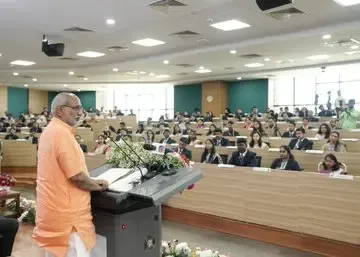Will RBI Cut Rates Again in Upcoming MPC Meeting?

Synopsis
Key Takeaways
- The RBI maintained its policy rate at 5.5 percent.
- Another rate cut is anticipated in the upcoming MPC meeting.
- Inflation projections have been revised down to 3.1 percent for FY26.
- External demand remains uncertain due to geopolitical tensions.
- The RBI is closely monitoring domestic growth and inflation dynamics.
New Delhi, Aug 6 (NationPress) According to Morgan Stanley's assessment on Wednesday, the Reserve Bank of India (RBI) is likely to implement an additional rate cut during its fourth quarter meeting (expected in October), especially in light of challenges stemming from tariff-related issues.
In a unanimous decision, the RBI Monetary Policy Committee (MPC) chose to keep the policy rate steady at 5.5 percent, aligning with market expectations. All members agreed to maintain a neutral stance.
As noted in the Morgan Stanley report, the policy statement highlighted that the currently favorable trend in headline inflation is expected to be temporary, largely due to decreased food prices. Economic growth is reportedly on track, and the effects of previous rate cuts are beginning to materialize, justifying the pause.
The RBI retained its GDP growth forecast at 6.5 percent year-on-year for FY26, supported by strong domestic demand.
However, external demand remains a concern due to ongoing uncertainties, driven by tariff negotiations, geopolitical tensions, and fluctuating global financial markets.
Regarding inflation, the RBI has revised its headline Consumer Price Index (CPI) projections down to 3.1 percent for FY26, from a previous estimate of 3.7 percent, mainly due to lower near-term inflation expectations.
The favorable inflation outlook is supported by reduced food inflation, even though core CPI remains slightly above the 4 percent threshold, as per the global financial institution.
The MPC has indicated a cautious approach by opting to pause, stating that, "Considering the current macroeconomic conditions, outlook, and uncertainties, it is prudent to maintain the policy repo rate at 5.5 percent and observe the further impact of the previously implemented rate cuts on credit markets and the wider economy.
The committee also resolved to closely monitor incoming data and the evolving dynamics of domestic growth and inflation to determine the most appropriate monetary policy direction.
The key factors to watch include high-frequency growth indicators, the trajectory of headline inflation, and developments related to trade agreements, as outlined in the report.









